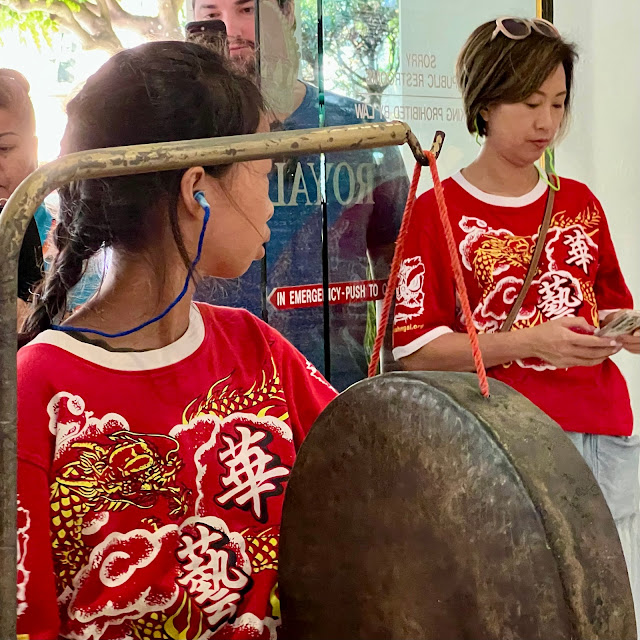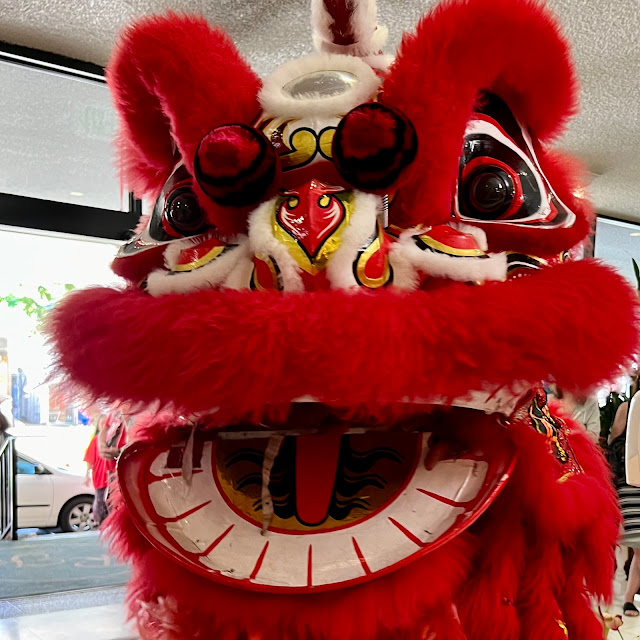Last year I read Peter Wohellben's wonderful book "The Hidden Life of Trees:
What They Feel, How They Communicate―Discoveries from a Secret World."
As I explored the Foster Botanical Garden in Honolulu with Terry the other day,
I couldn't help thinking about what its trees have experienced and perhaps communicated.
And I even crossed off a bucket list item, touching a giant kapok tree!
Touching a Giant, a Kapok Tree
Foster Botanical Garden
Honolulu, Oʻahu, Hawaiʻi, United States
February 15, 2024
© M. Louise (MacBeath) Barbour/Fundy Blue
All Rights Reserved
For many years in my teaching career I shared Lynne Cherry's
excellent book about the kapok tree and forest conservation.
Sadly in the thirty-four years since it was published,
we have only worsened the plight of of our natural world. Amazon
How I would have loved to share my pictures of the giant Kapok tree
in Foster Botanical Garden with my students.
It was magical! It's hard to imagine the scale of this giant,
which can reach 240 feet/73 meters in height and 19 feet/5.8 meters in diameter.
This giant kapok, Cieba pentandra, has been designated an exceptional tree
and is protected by a city ordinance.
© M. Louise (MacBeath) Barbour/Fundy Blue
All Rights Reserved
It was planted in 1850 by Dr. William Hillebrand, a physician and botanist,
who had a cottage in the middle terrace of the current gardens.
The kapok is native to tropical America and Africa.
Its wide buttresses support the tree in shallow soils
like the flying buttresses of Gothic cathedrals.
© M. Louise (MacBeath) Barbour/Fundy Blue
All Rights Reserved
In its native jungles, the kapok is home to many diverse species,including frogs, birds and bromeliads.
It's a deciduous tree that sprouts pink and white flowers
that attract bats which aid in pollination.
The kapok produces abundant seeds that are among
the first to colonize open areas in the forest.
The kapok is useful for humans too.
Its lightweight, porous wood is suitable for carving and making dugout canoes.
The seeds' silky fibers have been used in life preservers and bedding,
and the seeds' oil in soap.
Medicines have been created from other parts of this magnificent giant.
© M. Louise (MacBeath) Barbour/Fundy Blue
The Foster Botanical Garden site has an interesting history.
It was gifted to Queen Kalama, the wife of King Kamehameha III,
during the Great Mahele of 1848 when the Hawaiian Islands
were redistributed among the government, Hawaiian royalty, nobles, and commoners.
Queen Kalama leased some of the land to Dr. William Hillebrand
who imported many plants and animals to the islands,
including the ubiquitous mynah birds.
He, in turn, sold the land to "Captain" Thomas R. Foster,
a master shipbuilder from my native Nova Scotia.
His wife Mary gifted the land to the city and county of Honolulu,
stipulating that it be preserved as Foster Garden.
As a result people today can wander among the beauty and peace of this special place.
Near the Entrance to Foster Botanical Garden
© M. Louise (MacBeath) Barbour/Fundy Blue
All Rights Reserved
Beautiful Orchids in the Conservatory
© M. Louise (MacBeath) Barbour/Fundy Blue
There are many storied trees and plants in this oasis near Chinatown.
I'm sharing some photos of some of them:
1. Bo or Bodhi Tree:

Terry stands in front of the Garden's Bo Tree (Ficus religiosa)
© M. Louise (MacBeath) Barbour/Fundy Blue
All Rights Reserved
Buddha attained enlightenment under a revered Bodhi tree
at the Mahabodhi Temple in Sri Lanka. That tree dates to 288 BC.
A Buddist monk gave Mary Foster a clipping from that famous tree in 1913,
and it has grown into a giant here.
Mary developed a passionate belief in Buddhism and became the first Hawaiian Buddhist.
Replica of the Great Buddha of Kamakura
In 1968 the governor of Kanagawa Prefecture in Japan gave this statue to the City of Honolulu
to commemorate the centennial of the first Japanese immigrants arriving Hawai'i
© M. Louise (MacBeath) Barbour/Fundy Blue
2. Quipo Tree:
Quipo Tree (Cavanillesia platanifolia)
© M. Louise (MacBeath) Barbour/Fundy Blue
All Rights Reserved
Quipo Tree (Cavanillesia platanifolia)
© M. Louise (MacBeath) Barbour/Fundy Blue
This was the first tree I spotted, and I literally ran to it!
Planted in 1930, it is one of some twenty trees designated exceptional in the garden,
and it is protected by a city ordinance. It is breathtaking!
It is a flowering plant related to the giant hibiscus,
and it can grow to 197 feet/60 meters in height.
Its bark has characteristic rings,
and it produces leaves near the top of the tree for only one month a year.
3. Cycad:
Cycad: Encephalartos gratis
© M. Louise (MacBeath) Barbour/Fundy Blue
All Rights Reserved
Female Encephalartos gratis with Cones
© M. Louise (MacBeath) Barbour/Fundy Blue
Cycads are a very old order of tree dating back to about 280 million years ago in the Permian. They evolved long before flowering plants. Many are extinct in the wild. These two are found in Foster's Prehistoric Glen. They grow in Malawi and Mozambique.
I had fun walking among the Cycads and imagining a vanished world.
4. Cannonball Tree:
Two Cannonball Trees (Couroupita guianensis)
The cannonball tree on the left is the biggest in the USA. It was planted in 1931.
© M. Louise (MacBeath) Barbour/Fundy Blue
All Rights Reserved

.
Cannonball (Couroupita guianesis)
© M. Louise (MacBeath) Barbour/Fundy Blue
This tree is hard to see as a whole. Its orange flowers blossom on stems
growing from the trunk. It sports heavy round fruit
which could definitely give you a headache if one fell on you.
And everything is shrouded by thickets of its stems.
It is another of the protected trees designated as exceptional.
5. Loulu Palm:
Loulu Palm (Pritchardia Schattaueri)
© M. Louise (MacBeath) Barbour/Fundy Blue
All Rights Reserved
A tree just for me!
I shouldn't make light of it, because this species of Loulu palm is critically endangered with only a dozen specimens left in the wild in 2001. Endemic to the southwestern forests of the Island of Hawai'i, it is primarily found in botanical gardens. Habitat loss along with rats, weeds, and hoofed animals were and are threatening the survival of the species. The Nature Conservancy is working with other conservation organizations
to nurture seedlings at its Kona Hema Preserve.

"Beautiful Butterflies" by Bronzemen 2009
© M. Louise (MacBeath) Barbour/Fundy Blue
So many gorgeous trees and plants ~ It's hard to pick just a few.
I loved the Foster Botanical Garden, and I will return to it!
For Rain's TADD: Ladders:
Ladders at Battery Randolph with One of its 14-inch Canons (a model)
US Army Museum of Hawaii
Waikiki, Honolulu, O'ahu, Hawai'i
February 14, 2024
© M. Louise (MacBeath) Barbour/Fundy Blue
All Rights Reserved
For Tom's Aloha Friday: Surfing's Done!
Surfing's Done
Marina Beach
Waikiki, Honolulu, O'ahu, Hawai'i
February 17, 2024
© M. Louise (MacBeath) Barbour/Fundy Blue
For Nicoles's Friday Face Off: Funny Face
Terry Spotted This Funny Face!
Marina Beach
Waikiki, Honolulu, O'ahu, Hawai'i
February 17, 2024
© M. Louise (MacBeath) Barbour/Fundy Blue
Have a great weekend! 🌺 Aloha!!! 🌺
Till next time ~Fundy Blue
My next post will be soon! 🤞
On the Bay of Fundy
© M. Louise (MacBeath) Barbour/Fundy Blue
All Rights Reserved









































































